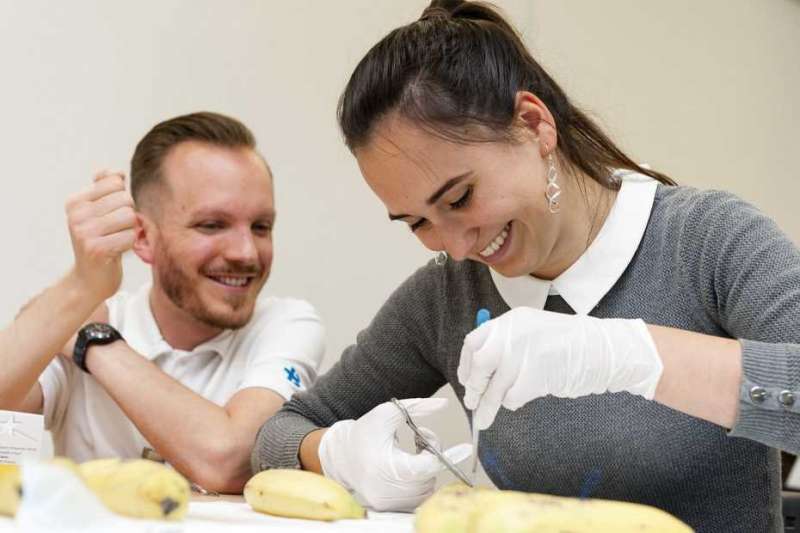Breaking new ground in medical training

With plenty of anticipation, ETH Zurich welcomed the first 100 students to its new Bachelor's degree in human medicine last autumn. The experiences of the first semester have resulted in a lot of enthusiasm – from the lecturers as well as the students.
It's a memorable image: medical students practising stitching wounds on bananas. And it's a perfect example of the new direction that ETH is taking with its medicine programme. "We have designed the new degree programme from the ground up," says ETH Rector Sarah Springman. "For example, the students get to visit a hospital in their first week of study."
Contextual learning
The idea behind this is "contextual learning", something which plays a significant role in ETH Zurich's new degree programme. An example: Monday morning, 8 a.m., the start of a themed week: a slipped disc is depicted. The students have used preparatory videos and other material to work through the theoretical basics of the spine in advance, mainly anatomy. During the course of the week, the topic is discussed by various lecturers from a variety of perspectives. Friday afternoon, 3 p.m. to 5 p.m.: the week ends with a clinical flagship lecture and a subsequent discussion.
This kind of teaching, combining theory and clinical application, has found its moment. Director of Studies Christian Wolfrum is delighted with it: "On Monday morning, all the students were there punctually at 8 a.m." When he asks a question, 30 arms shoot up in the air; in other lectures, he is more likely to see nodding heads. "I was a bit blindsided by it at first," he says with a laugh. On Friday evening, the students are still deep in discussion at 6.30 p.m. "All the lecturers are rhapsodising about the motivation of the ETH medical students and the interaction during lectures, even those that teach at other universities," says Wolfrum.
Content that's needed later
The new teaching concept was developed in close collaboration with Manu Kapur, Professor of Learning Sciences, who came to ETH Zurich from Hong Kong a year ago. "Professor Kapur can not only introduce new concepts thanks to his background, but also provides another perspective on medical training," says Professor Jörg Goldhahn, project manager for the medicine programme. The ETH programme therefore aims to provide content that the students will later need as doctors. "It's not about filling the students' heads with as many facts as possible," says Goldhahn, summing up the new approach.
The degree programme was thus structured backwards, led by the question: what will the students need at the end? How must the content be conveyed? This question also affects the examination methods. To be able to authentically test the content, ETH assessments were conducted on tablets for the first time. The new assessment methods aim to help the students learn the content properly.
Spreading to other degree programmes
ETH has the advantage of creating the Bachelor's programme from scratch, offering the space to test new ideas. "And we were fortunate enough to be able to count on the assistance of incredibly motivated colleagues in our partner institutions," says Rector Springman. That includes the hospitals and clinics, but above all the Universities of Zurich and Basel and the Università della Svizzera italiana, where the ETH undergraduates will complete their Master's. "Our partner institutions provide us with very active support, and we all benefit from the experience," says Springman. For example, new content that proves successful can also be adopted by other degree programmes – not only in ETH, but also further afield.



















